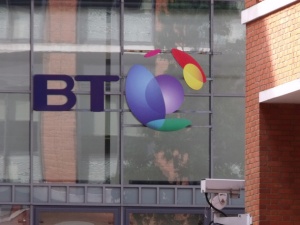BT: Nine in 10 homes will have fibre within six years

Ninety percent of premises in the UK will have access to fibre-based broadband by around 2017, BT chief Ian Livingston has predicted.

BT saw a 36-percent rise in pre-tax profit for the three months ending 30 September. Photo credit: Ell Brown/Flickr
Livingston made the prediction as the British telecoms giant released its second-quarter and half-year results on Thursday. BT announced a 36-percent rise in pre-tax profit to £552m for the three months ending 30 September, despite a 10-percent decline in revenue to £4.5bn.
The BT chief reiterated the company's pledge from Monday that two-thirds of the UK will be fibre-ready by the end of 2014 rather than 2015, as originally planned. He also praised the government's £530m pot — a good chunk of which is certain to go to BT — for extending coverage to relatively uneconomical rural areas.
"With the already-announced government support, we believe there is the potential for fibre-based services to reach more than 90 percent of the UK within a few years thereafter," Livingston said.
BT confirmed to ZDNet UK that Livingston was referring to 90 percent of premises having access to fibre-based broadband, rather than 90-percent geographical coverage.
"We expect to continue to offset the economic headwinds through improved customer service and processes, better efficiency and investment in the future of the business," Livingston said. "This strategy and our financial results allow us to invest when others are merely talking about it."
FTTC rollout
BT's super-fast broadband rollout is mostly based on fibre-to-the-cabinet (FTTC) technology, which currently delivers up to 40Mbps and will see speeds of up to 80Mbps next year. The FTTC approach involves running fibre to a street cabinet, then relying on the existing copper connection between the cabinet and individual homes and businesses to hook up customers.
However, some people will get full fibre-to-the-premises (FTTP), which theoretically goes up to 110Mbps by doing away with the copper.
BT Retail accounted for 63 percent of the 263,000 net additions to the wider company's infrastructure. This was a slight rise on the 250,000 homes and businesses that opened up a new broadband connection in the previous quarter.
In recent weeks, BT saw its six-millionth connection to its broadband network, the company said.
Both BT Retail and BT Wholesale saw small year-on-year decreases, of three and seven percent respectively, in their revenue for the third quarter. By contrast, there was a four-percent rise in revenue for Openreach, the division that runs the network and helps other ISPs use their own equipment rather than resell BT Wholesale's product.
BT Global Services, once a deeply troubled member of the BT family, continued its recent good fortune with a one-percent increase in revenue.
"Our investment in fast-developing regions is paying off as multinationals seek greater global connectivity," Global Services chief executive Jeff Kelly said in a statement. "Our order book in Asia Pacific has almost doubled, and we are investing across Latin America to achieve similar results."
Get the latest technology news and analysis, blogs and reviewsdelivered directly to your inbox with ="http: www.zdnet.co.uk="" newsletters="" "="">ZDNet UK'snewsletters.